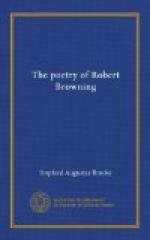As the years went on, these readers increased in number, but even when the volumes entitled Men and Women were published in 1855, and the Dramatis Personae in 1864, his followers were but a little company. For all this neglect Browning cared as a bird cares who sings for the love of singing, and who never muses in himself whether the wood is full or not of listeners. Being always a true artist, he could not stop versing and playing; and not one grain of villain envy touched his happy heart when he looked across the valley to Tennyson. He loved his mistress Art, and his love made him always joyful in creating.
At last his time came, but it was not till nearly twenty years after the Collected Poems of 1849 that The Ring and the Book astonished the reading public so much by its intellectual tour de force that it was felt to be unwise to ignore Browning any longer. His past work was now discovered, read and praised. It was not great success or worldwide fame that he attained, but it was pleasant to him, and those who already loved his poems rejoiced with him. Before he died he was widely read, never so much as Tennyson, but far more than he had ever expected. It had become clear to all the world that he sat on a rival height with Tennyson, above the rest of his fellow-poets.
Their public fate, then, was very different. Tennyson had fifty years of recognition, Browning barely ten. And to us who now know Browning this seems a strange thing. Had he been one of the smaller men, a modern specialist like Arnold or Rossetti, we could better understand it. But Browning’s work was not limited to any particular or temporary phase of human nature. He set himself to represent, as far as he could, all types of human nature; and, more audacious still, types taken from many diverse ages, nations and climates. He told us of times and folk as far apart as Caliban and Cleon, as Karshish and Waring, as Balaustion and Fifine, as St. John and Bishop Blougram. The range and the contrasts of his subjects are equally great. And he did this work with a searching analysis, a humorous keenness, a joyous boldness, and an opulent imagination at once penetrative and passionate. When, then, we realise this as we realise it now, we are the more astonished that appreciation of him lingered so long. Why did it not come at first, and why did it come in the end?
The first answer to that question is a general one. During the years between 1860 and 1890, and especially during the latter half of these years, science and criticism were predominant. Their determination to penetrate to the roots of things made a change in the general direction of thought and feeling on the main subjects of life. Analysis became dearer to men than synthesis, reasoning than imagination. Doubtful questions were submitted to intellectual decision alone. The Understanding, to its great surprise, was employed on the investigation of the




